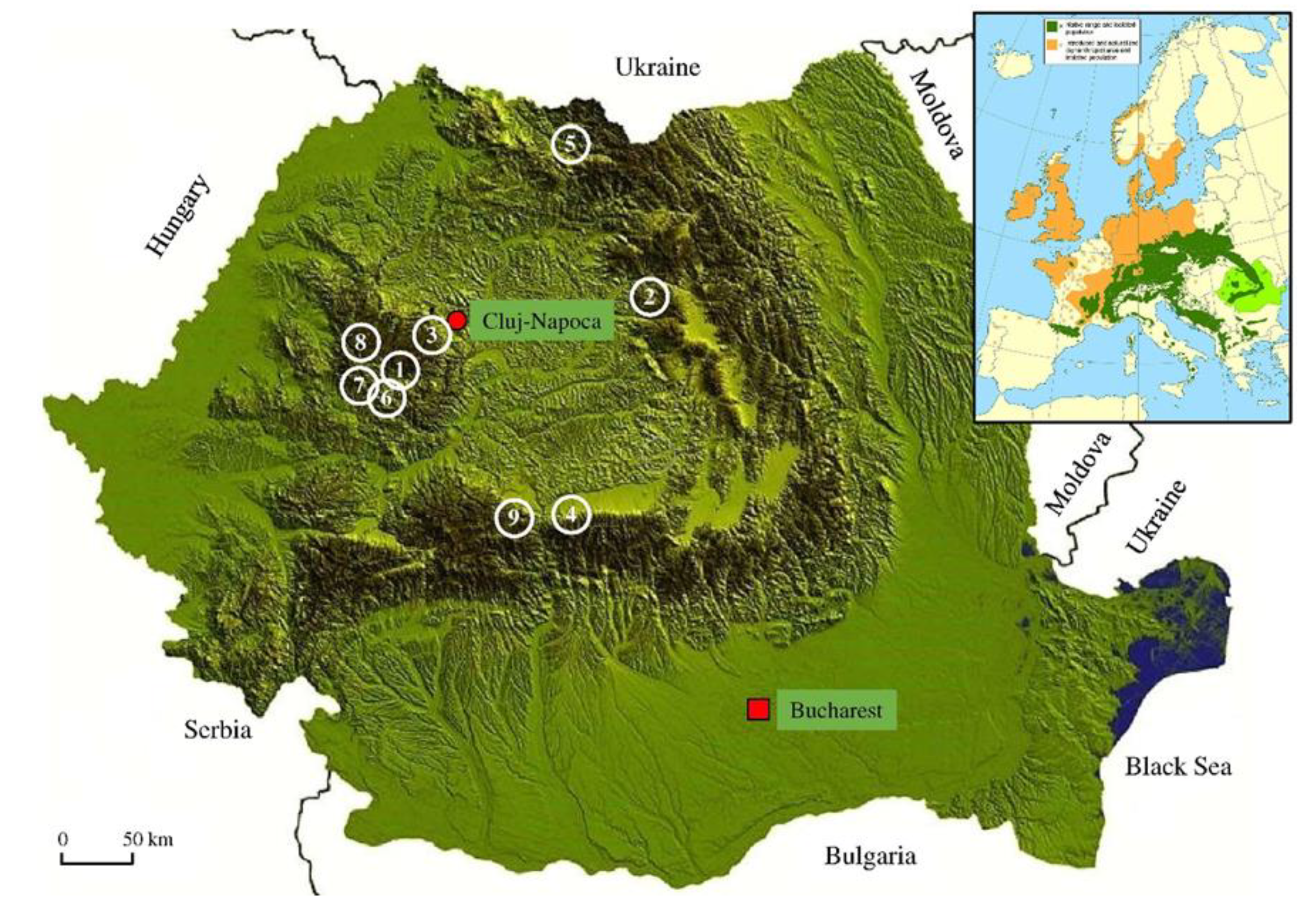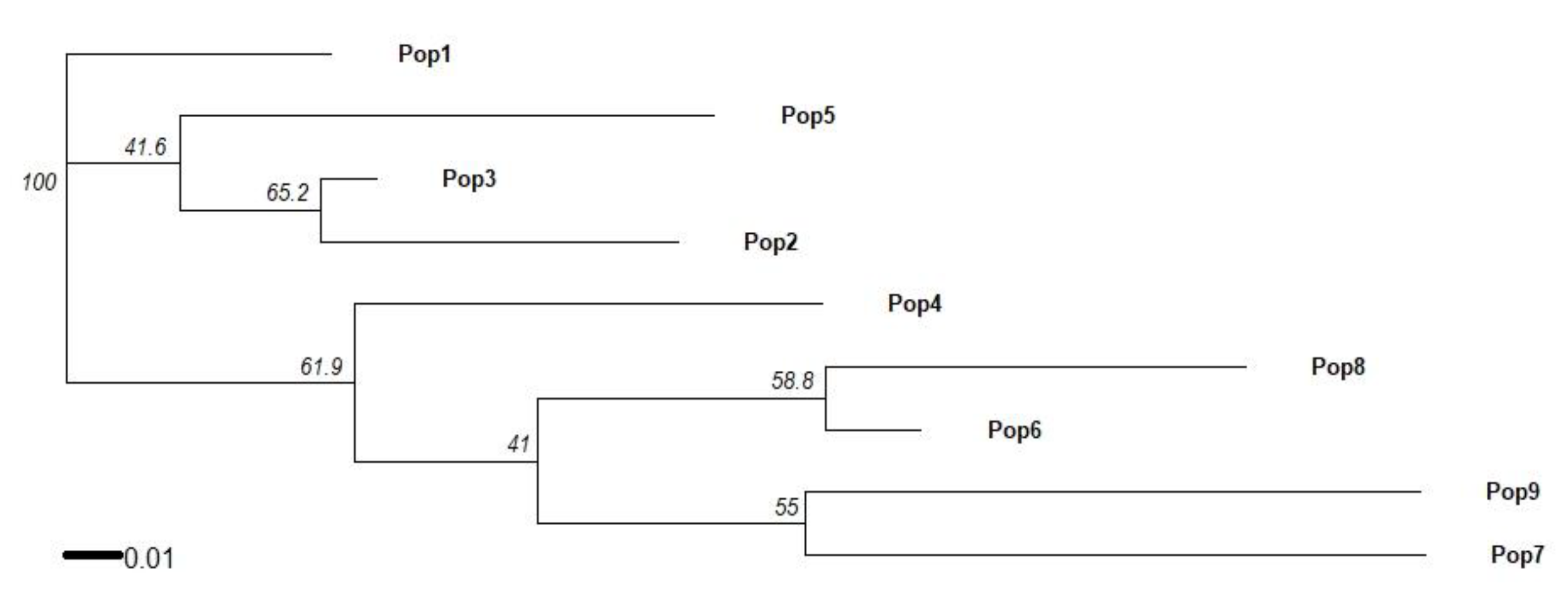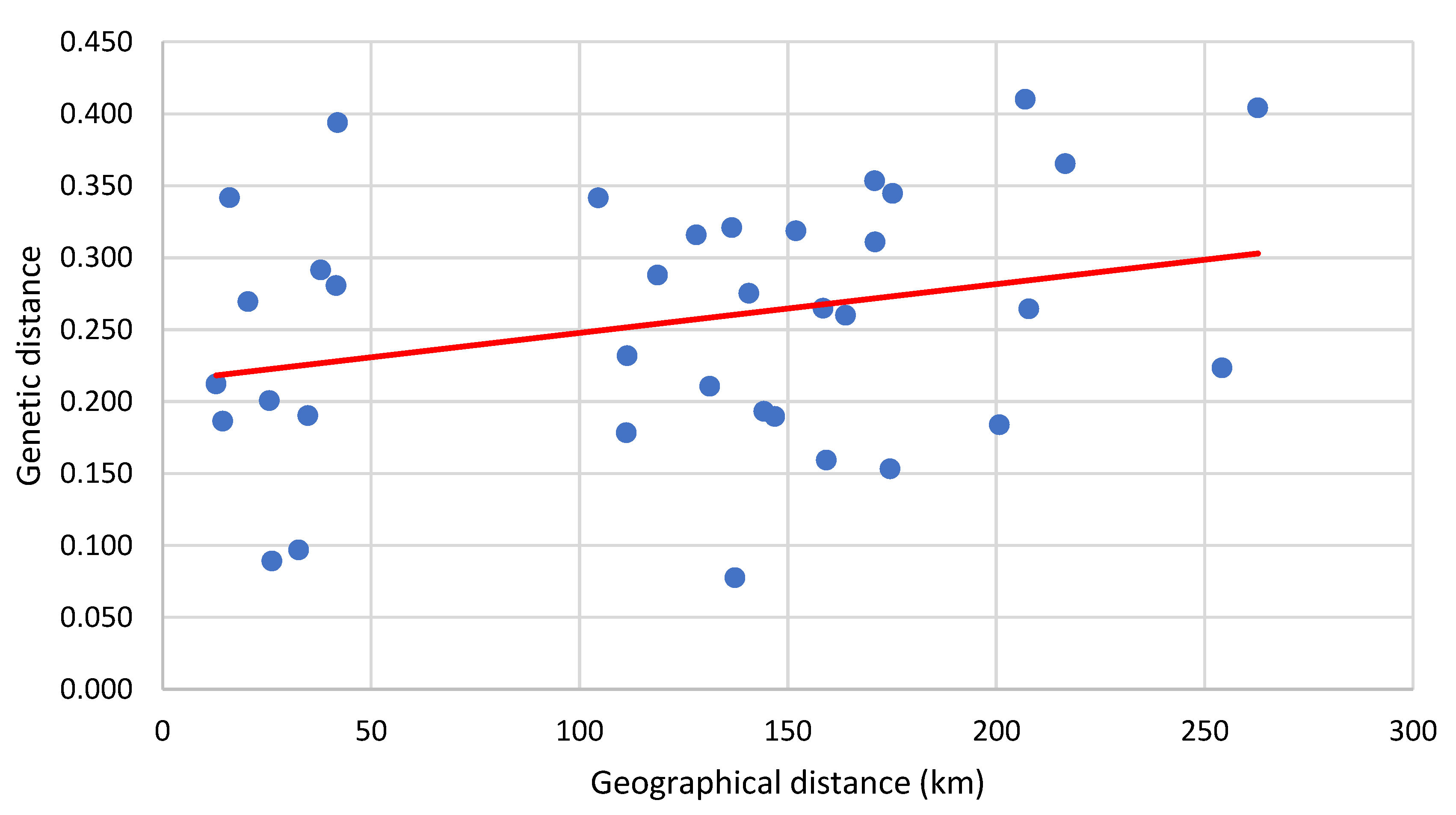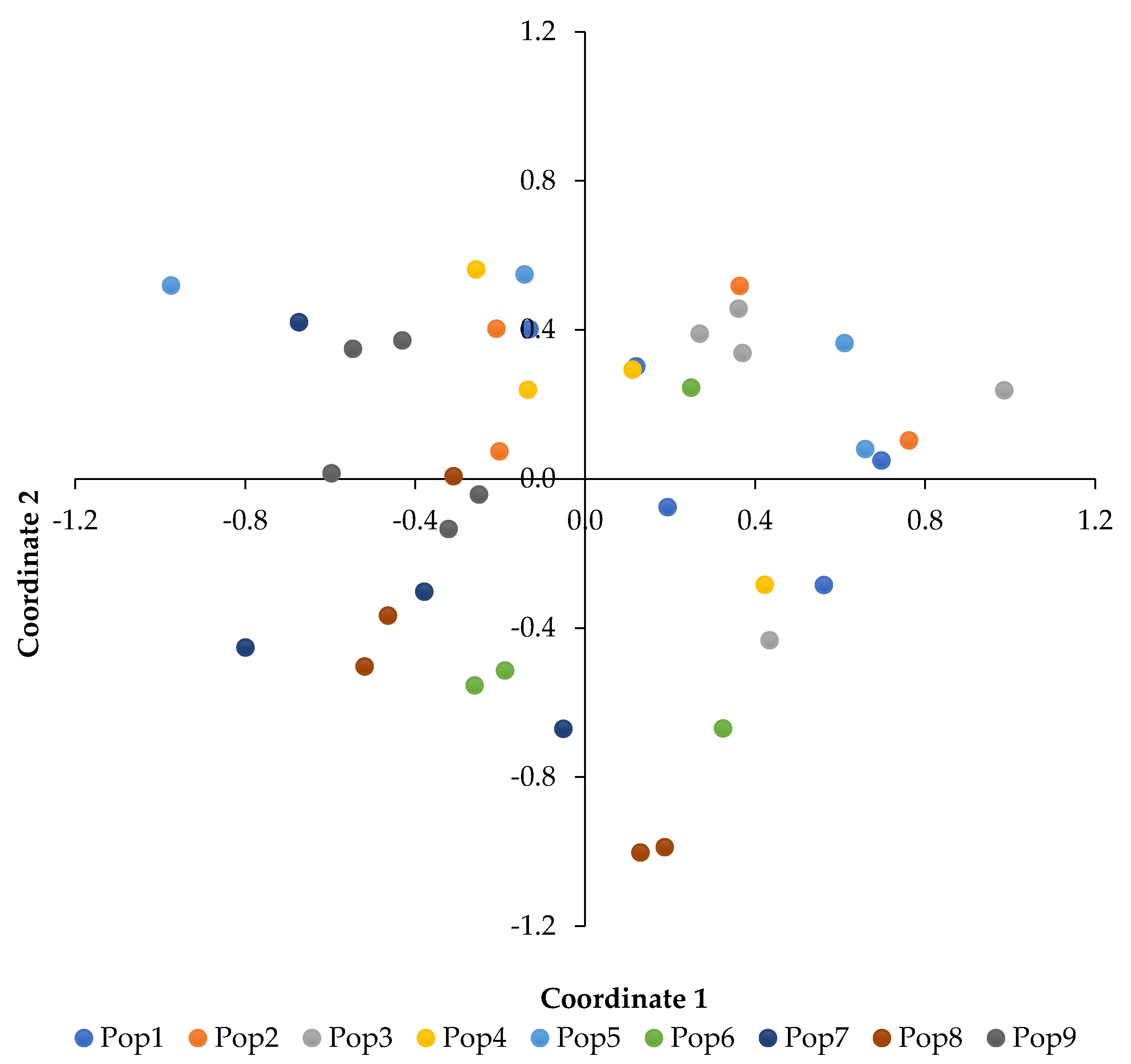Genetic Relationships and Reproductive Traits of Romanian Populations of Silver Fir (Abies alba): Implications for the Sustainable Management of Local Populations
Abstract
1. Introduction
2. Materials and Methods
2.1. Plant Material
2.2. Characterization of Female Cones, Seeds, and Seed Germination
2.3. DNA Extraction and SSR Genotyping
2.4. Data Analysis
3. Results
3.1. Characterisation of Silver Fir Female Cones
3.2. Seed Germination
3.3. SSR Characterisation
3.4. Genetic Relationships between Populations
3.5. Genetic Structure
3.6. Relationship between Germination, Seed Weight, and Genetic Parameters
4. Discussion
Author Contributions
Funding
Conflicts of Interest
References
- Dering, M.; Sękiewicz, K.; Boratyńska, K.; Litkowiec, M.; Iszkuło, G.; Romo, A.; Boratyński, A. Genetic diversity and inter-specific relations of western Mediterranean relic Abies taxa as compared to the Iberian Abies alba. Flora 2014, 209, 367–374. [Google Scholar] [CrossRef][Green Version]
- Schütt, P. Tannenarten Europas und Kleinasiens; Birkhüuser: Basel, Switzerland, 1991. [Google Scholar]
- Mauri, A.; De Rigo, D.; Caudullo, G. Abies alba in Europe: Distribution, habitat, usage and threats. In European Atlas of Forest Tree Species; Publication Office EU: Luxemburg, Luxemburg, 2016; p. e01493b. [Google Scholar]
- Tinner, W.; Colombaroli, D.; Heiri, O.; Henne, P.D.; Steinacher, M.; Untenecker, J.; Vescovi, E.; Allen, J.R.M.; Carraro, G.; Conedera, M.; et al. The past ecology of Abies alba provides new perspectives on future responses of silver fir forests to global warming. Ecol. Monog. 2013, 83, 419–439. [Google Scholar] [CrossRef]
- Dobrowolska, D.; Bončina, A.; Klumpp, R. Ecology and silviculture of silver fir (Abies alba Mill.): A review. J. For. Res. 2017, 22, 326–335. [Google Scholar] [CrossRef]
- Todea, I.M.; González-Orenga, S.; Boscaiu, M.; Plazas, M.; Sestras, A.F.; Prohens, J.; Vicente, O.; Sestras, R.E. Responses to water deficit and salt stress in silver fir (Abies alba Mill.) seedlings. Forests 2020, 11, 395. [Google Scholar] [CrossRef]
- Todea, I.M.; González-Orenga, S.; Plazas, M.; Sestras, A.F.; Prohens, J.; Vicente, O.; Sestras, R.E.; Boscaiu, M. Screening for salt and water stress tolerance in fir (Abies alba) populations. Not. Bot. Horti Agrobot. 2019, 47, 1063–1072. [Google Scholar] [CrossRef]
- Schütz, J.P. Silvicultural tools to develop irregular and diverse forest structures. Forestry 2002, 75, 327–337. [Google Scholar] [CrossRef]
- Wolf, H. EUFORGEN Technical Guidelines for Genetic Conservation and Use of Silver Fir (Abies alba); International Plant Genetic Resources Institute: Rome, Italy, 2003. [Google Scholar]
- Giurgiu, V. Compoziţii Optime pentru Pădurile României; Editura Ceres: Bucureşti, Romania, 2005; p. 263. [Google Scholar]
- Plesa, I.; Dan, C.; Truța, A.; Holonec, L.; Sestras, A.F.; Boscaiu, M.; Sestras, R.E. Spruce trees growth and forest landscape depending on microstational factors and ecological conditions. Not. Sci. Biol. 2017, 9, 582–588. [Google Scholar] [CrossRef]
- Sestras, P.; Bondrea, M.V.; Cetean, H.; Sălăgean, T.; Bilaşco, S.; Naș, S.; Spalevic, V.; Fountas, S.; Cîmpeanu, S.M. Ameliorative, ecological and landscape roles of Făget Forest, Cluj-Napoca, Romania, and possibilities of avoiding risks based on GIS landslide susceptibility map. Not. Bot. Horti Agrobot. 2018, 46, 292–300. [Google Scholar] [CrossRef]
- Bončina, A.; Simončič, T.; Rosset, C. Assessment of the concept of forest functions in Central European forestry. Environ. Sci. Policy 2019, 99, 123–135. [Google Scholar] [CrossRef]
- Barbu, I.; Barbu, C. Silver Fir (Abies alba Mill.) in Romania; Editura Tehnică Silvică: Câmpulung Moldovenesc, Romania, 2005; p. 220. [Google Scholar]
- Mihai, G. Îngrijirea, Întreţinerea şi Conducerea Plantajelor Gospodărite de RNP—Romsilva în Vederea Stimulării Fructificaţiei; Manuscris INCDS Marin Drăcea: Bucharest, Romania, 2015; p. 35. [Google Scholar]
- Gagov, V. Variability in seeds of Abies alba from different populations in Bulgaria. Naučni Trudove, Visš Lesotechničeski Institut. Sofija 1973, 19, 51–60. [Google Scholar]
- Gradečki, M.; Poštenjak, K. Germination of silver fir seeds (Abies alba Mill.) from different seed stands in Croatia. In Proceedings of the ISTA Forest Tree and Shrub Seed Committee Workshop, Prague—Průhonice, Czech Republic, 20–22 October 2003; p. 90. [Google Scholar]
- Skrzyszewska, K.; Chłanda, J. A study on the variation of morphological characteristics of silver fir (Abies alba Mill.) seeds and their internal structure determined by X-ray radiography in the Beskid Sądecki and Beskid Niski mountain ranges of the Carpathians (southern Poland). J. For. Sci. 2009, 55, 403–414. [Google Scholar] [CrossRef]
- Gradečki-Poštenjak, M.; Ćelepirović, N. The influence of crown defoliation on the variability of some physiological and morphological properties of silver fir (Abies alba Mill.) seeds in the seed zone of Dinaric beech-fir forests in Croatia. Period. Biol. 2015, 117, 479–492. [Google Scholar] [CrossRef]
- Gömöry, D.; Paule, L.; Krajmerová, D.; Romšáková, I.; Longauer, R. Admixture of genetic lineages of different glacial origin: A case study of Abies alba Mill. in the Carpathians. Plant Syst. Evol. 2012, 298, 703–712. [Google Scholar] [CrossRef]
- Postolache, D.; Leonarduzzi, C.; Piotti, A.; Spanu, I.; Roig, A.; Fady, B.; Roschanski, A.; Liepelt, S.; Vendramin, G.G. Transcriptome versus genomic microsatellite markers: Highly informative multiplexes for genotyping Abies alba Mill. and congeneric species. Plant Mol. Biol. Rep. 2014, 32, 750–760. [Google Scholar] [CrossRef]
- Postolache, D.; Popescu, F.; Pitar, D.; Apostol, E.N.; Iordan, A.; Avram, A.; Iordan, O.; Zhelev, P. The origin, evolution and genetic structure of fir trees in Romania evaluated through molecular markers. Rev. Silvic. Cineg. 2016, 38, 8–19. [Google Scholar]
- De Luca, D.; Menale, B.; Caputo, P.; Cennamo, P. Population genetics analysis in a relic population of silver fir (Abies alba Mill) in southern Italy: A comparison with microsatellites and references data. Plant Biosyst. 2017, 131, 479–491. [Google Scholar] [CrossRef]
- Belletti, P.; Ferrazzini, D.; Ducci, F.; De Rogatis, A.; Mucciarelli, M. Genetic diversity of Italian populations of Abies alba. Dendrobiology 2017, 77, 147–159. [Google Scholar] [CrossRef]
- Popović, V.; Lućic, A.; Rakonjac, L.; Cvjetković, B.; Milovanović, J.; Mladenović Drinić, S.; Ristić, D. Application of SSR markers for the assessment of genetic differentiation of silver fir (Abies alba Mill.) originating from Javor mountain. Genetika 2019, 51, 1103–1112. [Google Scholar] [CrossRef]
- Popović, V.; Lućic, A.; Rakonjac, L.; Cvjetković, B.; Mladenović Drinić, S.; Ristić, D. Assessment of genetic diversity of silver fir (Abies alba Mill.) in Serbia using SSR markers. Genetika 2017, 49, 979–988. [Google Scholar]
- Kathleen, D.; Rubio de Casas, R.; Burghardt, L.; Kovach, K.; Willis, G.W. Germination, Postgermination Adaptation, and Species Ecological Ranges. Annu. Rev. Ecol. Evol. Syst. 2010, 41, 293–319. [Google Scholar]
- Slate, J.; David, P.; Dodds, K.; Veenvliet, B.A.; Glass, B.C.; Broad, T.E.; McEwan, J.C. Understanding the relationship between the inbreeding coefficient and multilocus heterozygosity: Theoretical expectations and empirical data. Heredity 2004, 93, 255–265. [Google Scholar] [CrossRef] [PubMed]
- Pârnuţă, G.; Stuparu, E.; Budeanu, M.; Scărlătescu, V.; Marica, F.-M.; Lalu, I.; Filat, M.; Tudoroiu, M.; Lorenţ, A.; Daia, M.; et al. Catalogul Naţional al Resurselor Genetice Forestiere (National Catalogue of Forest Genetic Resources); Silvică Publishing House: Bucharest, Romania, 2011; p. 525. (In Romanian) [Google Scholar]
- Caudullo, G.; Welk, E.; San-Miguel-Ayanz, J. Chorological maps for the main European woody species. Data Brief 2017, 12, 662–666. [Google Scholar] [CrossRef] [PubMed]
- Haralamb, M. Cultura Speciilor Forestiere; Editura Agro-Silvică: Bucureşti, Romania, 1963; p. 778. [Google Scholar]
- Damian, I. Împăduriri; Editura Didactică şi Pedagogică: Bucureşti, Romania, 1978; p. 374. [Google Scholar]
- Vlase, I. Conservarea Seminţelor Forestiere; Editura Ceres: Bucureşti, Romania, 1982; p. 277. [Google Scholar]
- Alonso-Martín, D.; Gramazio, P.; Plazas, M.; Villanueva, G.; García-Fortea, E.; Díez, M.J.; Prohens, J.; Vilanova, S. Protocolo innovador para la obtención de ADN genómico vegetal de alta calidad. In Proceedings of the I Congreso de Jóvenes Investigadores en Ciencias Agroalimentarias, University of Almería, Almería, Spain, 20 December 2018; pp. 276–277. [Google Scholar]
- Doyle, J.J.; Doyle, J.L. Isolation of plant DNA from fresh tissue. Focus 1990, 12, 13–15. [Google Scholar]
- Hansen, O.K.; Vendramin, G.G.; Sebastiani, F.; Edwards, K.J. Development of microsatellite markers in Abies nordmanniana (Stev.) Spach and cross-species amplification in the Abies genus. Mol. Ecol. Notes 2005, 5, 784–787. [Google Scholar] [CrossRef]
- Cremer, E.; Liepelt, S.; Sebastiani, F.; Buonamici, A.; Michalczyck, I.M.; Ziegenhagen, B.; Vendramin, G.G. Identification and characterization of nuclear microsatellite loci in Abies alba Mill. Mol. Ecol. Notes 2006, 6, 374–376. [Google Scholar] [CrossRef]
- Peakall, R.O.D.; Smouse, P.E. GenAlEx 6.5: Genetic analysis in Excel. Population genetic software for teaching and research-an update. Bioinformatics 2012, 28, 2537–2539. [Google Scholar] [CrossRef]
- Jombart, T.; Ahmed, I. adegenet 1.3-1: New tools for the analysis of genome-wide SNP data. Bioinformatics 2011, 27, 3070–3071. [Google Scholar] [CrossRef]
- Kamvar, Z.N.; Tabima, J.F.; Grünwald, N.J. Poppr: An R package for genetic analysis of populations with clonal, partially clonal, and/or sexual reproduction. PeerJ 2014, 2, e281. [Google Scholar] [CrossRef]
- Schliep, K.; Potts, A.J.; Morrison, D.A.; Grimm, G.W. Intertwining phylogenetic trees and networks. Methods Ecol. Evol. 2017, 8, 1212–1220. [Google Scholar] [CrossRef]
- Nei, M. Genetic distance between populations. Am. Nat. 1972, 106, 283–292. [Google Scholar] [CrossRef]
- Saitou, N.; Nei, M. The neighbor-joining method: A new method for reconstructing phylogenetic trees. Mol. Biol. Evol. 1987, 4, 406–425. [Google Scholar] [PubMed]
- Excoffier, L.; Smouse, P.E.; Quattro, J.M. Analysis of molecular variance inferred from metric distances among DNA haplotypes: Application to human mithocondrial DNA restriction data. Genetics 1992, 131, 479–491. [Google Scholar] [PubMed]
- Verdú, M.; Traveset, A. Early emergence enhances plant fitness: A phylogenetically controlled meta-analysis. Ecology 2005, 86, 1385–1394. [Google Scholar] [CrossRef]
- Sabor, J. Zależność między ciężarem a zdolnością kiełkowania nasion jodły pospolitej. Sylwan 1984, 127, 59–69. [Google Scholar]
- Sorensen, F.C. Relationship between self-fertility, allocation of growth, and inbreeding depression in three coniferous species. Evolution 1999, 53, 417–425. [Google Scholar] [CrossRef]
- Rajora, O.A.; Mosseler, A. Challenges and opportunities for conservation of forest genetic resources. Euphytica 2001, 118, 197–212. [Google Scholar] [CrossRef]
- Tracz, M.; Barzdajn, W. The morphological traits of cones and seeds of Abies alba in the Middle Sudeten. Dendrobiology 2007, 58, 59–65. [Google Scholar]
- Kaliniewicz, Z.; Markowski, P.; Anders, A.; Jadwisieńczak, K.; Żuk, Z.; Krzysiak, Z. Physical properties of seeds of eleven fir species. Forests 2019, 10, 142. [Google Scholar] [CrossRef]
- Cremer, E.; Ziegenhagen, B.; Schulerowitz, K.; Mengel, C.; Donges, K.; Bialozyt, R.; Hussendörfer, E.; Liepelt, S. Local seed dispersal in European silver fir (Abies alba Mill.): Lessons learned from a seed trap experiment. Trees 2012, 26, 987–996. [Google Scholar] [CrossRef]
- Carles, S.; Lamhamedi, M.S.; Beaulieu, J.; Stowe, D.C.; Colas, F.; Margolis, H.A. Genetic variation in seed size and germination patterns and their effect on white spruce seedling characteristics. Silvae Genet. 2009, 58, 152–161. [Google Scholar] [CrossRef]
- Bussotti, P.; Pollastrini, M.; Holland, V.; Brüggemann, W. Functional traits and adaptive capacity of European forests to climate change. Env. Exp. Bot. 2015, 111, 91–113. [Google Scholar] [CrossRef]
- Teodosiu, M.; Mihai, G.; Fussi, B.; Ciocîrlan, E. Genetic diversity and structure of silver fir (Abies alba Mill.) at the south-eastern limit of its distribution range. Ann. For. Res. 2019, 62, 139–156. [Google Scholar] [CrossRef]
- Pandey, M.K.; Gautami, B.; Jayakumar, T.; Sriswathi, M.; Upadhyaya, H.D.; Godwa, M.V.C.; Radhakrishnan, T.; Bertioli, D.; Knapp, S.J.; Cook, D.R.; et al. Highly informative genic and genomic SSR markers to facilitate molecular breeding in cultivated groundnut (Arachis hypogaea). Plant Breed. 2012, 131, 139–147. [Google Scholar] [CrossRef]
- Martin, M.A.; Mattioni, C.; Cherubini, M.; Taurchini, D.; Villani, F. Genetic diversity in European chestnut populations by means of genomic and genic microsatellite markers. Tree Genet. Genom. 2010, 6, 735–744. [Google Scholar] [CrossRef]
- Muñoz-Falcón, J.E.; Vilanova, S.; Plazas, M.; Prohens, J. Diversity, relationships, and genetic fingerprinting of the Listada de Gandía eggplant landrace using genomic SSRs and EST-SSRs. Sci. Hort. 2011, 129, 238–246. [Google Scholar] [CrossRef]
- Nandha, P.S.; Singh, J. Comparative assessment of genetic diversity between wild and cultivated barley using gSSR and EST-SSR markers. Plant Breed. 2014, 133, 28–35. [Google Scholar] [CrossRef]
- Vilcan, A.; Mihalte, L.; Sestras, A.F.; Holonec, L.; Sestras, R.E. Genetic variation and potential genetic resources of several Romanian larch populations. Turk. J. Agric. For. 2017, 41, 82–91. [Google Scholar] [CrossRef]
- Gramazio, P.; Plesa, I.M.; Truta, A.M.; Sestras, A.F.; Vilanova, S.; Plazas, M.; Vicente, O.; Boscaiu, M.; Prohens, J.; Sestras, R.E. Highly informative SSR genotyping reveals large genetic diversity and limited differentiation in European larch (Larix decidua) populations from Romania. Turk. J. Agric. For. 2018, 42, 165–175. [Google Scholar] [CrossRef]




| Code | Population | County | Administrative Location | Latitude/Longitude | Altitude (m asl) |
|---|---|---|---|---|---|
| 1 | Valea Bistrei | Alba | OSP. Abrud, UP III, u.a. 228B | 46°27′ N/23°01′ E | 1050–1325 |
| 2 | Iod | Mureș | OS. Răstolnița UP VI-67 A | 46°56′ N/24°59′ E | 670–1063 |
| 3 | Someșul Rece | Cluj | OS. Someșul Rece UP I u.a. 92A | 46°38′ N/23°14′ E | 690–1250 |
| 4 | Avrig | Sibiu | OS Izvorul Florii UP III u.a 75A | 45°37′ N/24°27′ E | 900–1150 |
| 5 | Budescu | Maramureș | OS. Poieni, UP IV, u.a 96 A | 47°54′ N/24°36′ E | 860–1120 |
| 6 | Sohodol | Alba | OSP. Abrud UP 18 C | 46°20′ N/23°06′ E | 870–1030 |
| 7 | Valea Morii | Alba | OSP. Abrud U V, u.a 39 | 46°19′ N/22°56′ E | 1080–982 |
| 8 | Gârda Seacă | Alba | OS. Gârda UP VI, u.a 20 H | 46°31′ N/22°46′ E | 1090–1285 |
| 9 | Sadu | Sibiu | OS. Valea Sadului UP II, u.a 75 A | 45°35′ N/23°55′ E | 1100–1350 |
| Locus | Primer Sequence (5’–3’) | Dye a | Size Range (bp) |
|---|---|---|---|
| Multiplex A (EST-SSRs) | |||
| Aat01 | F: CCATGTCTCCGATTTCCAGT R: GGCCTAACGAAAGCAGAATC | FAM | 103–127 |
| Aat02 | F: AGAAGATTTCCCGGCTTTTC R: ATCCAGACAGCGAACTTTGG | VIC | 123–129 |
| Aat03 | F: TCCCCATGGTTTGGTTAAAA R: CGAAGAAAATGTTGCGGAAT | PET | 149–161 |
| Aat04 | F: CCATGTATGGTGCTCCTCCT R: CCTTCATTGCAGAAAAGCAA | FAM | 158–191 |
| Aat05 | F: AGCATCCACATTCCGTAACC R: AGTTGACCGTTGGAGAGCAG | VIC | 177–192 |
| Aat06 | F: TTATGCGGAGCAGTTCTGTG R: TGTTGCTGGCGTACTGGTAG | NED | 196–214 |
| Aat07 | F: GCTAGCAGAACCCTGGAATG R: GGTGGGATATTTCCAGCAAG | PET | 219–241 |
| Aat08 | F: ACTCCATCACGGTGGTCTTC R: GCCATTCAGGCTCTCAGTTC | NED | 302–312 |
| Multiplex B (EST-SSRs) | |||
| Aat09 | F: CAGATCCTCCCACATCCAAC R: TGACACCACAGGAAACCATC | NED | 150–156 |
| Aat10 | F: GAGCACGATGAAGAGGAAGC R: AAAACCCCCACGCGGTAT | FAM | 226–250 |
| Aat11 | F: AGCGTTGATTGGAAGCAGTC R: GAAGCATGGTGTCGTTGTTG | VIC | 255–270 |
| Aat12 | F: ATCCATATCTCCTGCCTTGC R: CTTTCCAGGTGATCTGATTGC | PET | 303–349 |
| Aat13 | F: ACTCAAAGCCAAGCTGGAGA R: TGCATAAGACAGCCGAGTCA | FAM | 326–342 |
| Aat14 | F: GACTGGGGATCCTGCTGTTA R: AGAGGAGGCAGCCCATACAT | VIC | 358-394 |
| Aat15 | F: AGGAGGAGGTTCAGCATGTC R: CTTGCTCTCTGACCCAGTTG | NED | 361–373 |
| Aat16 | F: AACCACCGCTGATATTTTGG R: GGGTTCAAGAAATGGGAATG | PET | 427–430 |
| Multiplex C (gSSRs) | |||
| SFg6 | F: GTAACAATAAAAGGAAGCTACG R: TGTGACACATTGGACACC | VIC | 103–111 |
| SF324 | F: TTTGAACGGAAATCAAATTCC R: AAGAACGACACCATTCTCAC | PET | 105–120 |
| NFF7 | F: CCCAAACTGGAAGATTGGAC R: ATCGCCATCCATCATCAGA | VIC | 116–174 |
| SFb5 | F: AAAAAGCATCACTTTTCTCG R: AAGAGGAGGGGAGTTACAAG | FAM | 138–160 |
| SFb4 | F: GCCTTTGCAACATAATTGG R: TCACAATTGTTATGTGTGTGG | NED | 149–205 |
| Aag01 | F: GCTTATTCTCACTGCTCGCC R: ATGACTTGAAGGTGGATGCC | PET | 193–250 |
| SF1 | F: TTGACGTGATTAACAATCCA R: AAGAACGACACCATTCTCAC | VIC | 208–229 |
| Aag02 | F: TATTCCTCCACTTGGGTGCT R: GGTGGAGATCCGTATGCAAT | FAM | 208–250 |
| Population | Cone Length (mm) | Cone Diameter (mm) | Cone Length/Diameter | Number of Seeds per Cone | Seed Length (mm) | Seed Weight (mg) |
|---|---|---|---|---|---|---|
| 1 | 79.5 a | 42.9 c | 1.86 a | 144.2 b | 20.7 b | 48 b |
| 2 | 133.6 cd | 40.6 bc | 3.29 ab | 213.5 d | 21.0 b | 78 d |
| 3 | 126.3 cd | 38.1 abc | 3.35 ab | 162.9 bc | 23.8 b | 60 bc |
| 4 | 104.6 b | 37.7 abc | 2.80 a | 173.0 bcd | 17.1 a | 38 a |
| 5 | 120.2 c | 61.0 d | 1.99 a | 185.4 bcd | 22.7 b | 52 bc |
| 6 | 94.8 b | 41.7 bc | 2.29 a | 111.3 a | 20.8 b | 57 bc |
| 7 | 139.8 d | 39.2 abc | 3.62 ab | 166.5 bc | 26.0 c | 58 bc |
| 8 | 123.6 cd | 33.5 a | 3.70 ab | 288.8 e | 22.1 b | 60 bc |
| 9 | 134.9 cd | 35.4 ab | 4.92 c | 190.3 cd | 22.3 b | 63 c |
| Population | INCDS Standard | Dry Sand Layer | Control (Sand and Soil) | Wet Sand | Open Spaces in Cold Rooms | Average |
|---|---|---|---|---|---|---|
| 1 | 21.0 | 16.5 | 23.0 | 31.0 | 17.0 | 21.7 ab |
| 2 | 18.5 | 15.5 | 22.5 | 39.5 | 21.0 | 23.4 abc |
| 3 | 11.0 | 15.5 | 15.5 | 42.0 | 15.5 | 19.9 a |
| 4 | 13.0 | 13.0 | 22.5 | 29.0 | 20.0 | 19.5 a |
| 5 | 29.5 | 21.0 | 22.5 | 41.0 | 20.0 | 26.8 bc |
| 6 | 31.5 | 19.5 | 26.0 | 40.5 | 21.0 | 27.7 bc |
| 7 | 22.5 | 15.0 | 26.0 | 47.5 | 20.5 | 26.3 bc |
| 8 | 36.0 | 28.0 | 40.0 | 62.5 | 27.0 | 38.7 d |
| 9 | 23.5 | 23.5 | 36.0 | 49.0 | 27.0 | 31.8 c |
| Average | 22.9 b | 18.6 a | 26.0 c | 42.4 d | 21.0 ab |
| Locus | N | Ne | f | Ho | He | Fis | PIC |
|---|---|---|---|---|---|---|---|
| Aat01 | 3 | 1.65 | 0.725 | 0.344 | 0.348 | 0.012 | 0.3327 |
| Aat03 | 2 | 1.55 | 0.737 | 0.426 | 0.328 | −0.297 | 0.3125 |
| Aat05 | 4 | 1.59 | 0.775 | 0.172 | 0.298 | 0.423 | 0.3448 |
| Aat06 | 2 | 1.23 | 0.775 | 0.000 | 0.133 | 1.000 | 0.2879 |
| Aat07 | 6 | 1.79 | 0.600 | 0.259 | 0.371 | 0.300 | 0.5471 |
| Aat13 | 2 | 1.17 | 0.900 | 0.000 | 0.095 | 1.000 | 0.1638 |
| Aat14 | 9 | 2.13 | 0.303 | 0.206 | 0.480 | 0.572 | 0.7657 |
| Aat16 | 2 | 1.20 | 0.913 | 0.172 | 0.133 | −0.298 | 0.1469 |
| SFb5 | 7 | 1.99 | 0.632 | 0.000 | 0.477 | 1.000 | 0.4936 |
| NFF7 | 15 | 2.86 | 0.278 | 0.000 | 0.628 | 1.000 | 0.8416 |
| SF324 | 4 | 1.41 | 0.857 | 0.000 | 0.202 | 1.000 | 0.2474 |
| Aag01 | 6 | 1.90 | 0.543 | 0.096 | 0.458 | 0.790 | 0.5884 |
| Mean | 5.17 | 1.71 | 0.670 | 0.140 | 0.329 | 0.542 | 0.4227 |
| Population | n | P% | N | Ne | Ho | He | Fis |
|---|---|---|---|---|---|---|---|
| 1 | 5 | 58.3 | 4.67 | 1.92 | 0.060 | 0.276 | 0.709 |
| 2 | 4 | 50.0 | 3.50 | 1.58 | 0.090 | 0.209 | 0.508 |
| 3 | 5 | 58.3 | 4.83 | 2.00 | 0.090 | 0.261 | 0.512 |
| 4 | 4 | 75.0 | 3.50 | 1.83 | 0.060 | 0.316 | 0.687 |
| 5 | 4 | 75.0 | 3.67 | 2.00 | 0.150 | 0.376 | 0.600 |
| 6 | 4 | 66.7 | 4.00 | 1.92 | 0.100 | 0.299 | 0.524 |
| 7 | 4 | 91.7 | 3.83 | 2.17 | 0.260 | 0.402 | 0.261 |
| 8 | 5 | 91.7 | 4.83 | 2.50 | 0.220 | 0.398 | 0.376 |
| 9 | 5 | 91.7 | 4.67 | 2.50 | 0.230 | 0.425 | 0.387 |
| Mean | 73.2 | 4.17 | 2.05 | 0.140 | 0.329 | 0.507 |
| Pop. 1 | Pop. 2 | Pop. 3 | Pop. 4 | Pop. 5 | Pop. 6 | Pop. 7 | Pop. 8 | |
|---|---|---|---|---|---|---|---|---|
| Pop. 2 | 0.159 | |||||||
| Pop. 3 | 0.089 | 0.077 | ||||||
| Pop. 4 | 0.193 | 0.319 | 0.190 | |||||
| Pop. 5 | 0.184 | 0.178 | 0.153 | 0.223 | ||||
| Pop. 6 | 0.186 | 0.265 | 0.190 | 0.210 | 0.264 | |||
| Pop. 7 | 0.342 | 0.353 | 0.394 | 0.275 | 0.365 | 0.212 | ||
| Pop. 8 | 0.269 | 0.345 | 0.291 | 0.260 | 0.410 | 0.097 | 0.200 | |
| Pop. 9 | 0.288 | 0.311 | 0.316 | 0.280 | 0.404 | 0.341 | 0.232 | 0.321 |
| Source of Variation | Degrees of Freedom | Sums of Squares | Mean Squares | Variance of Components | Percentage of Variation |
|---|---|---|---|---|---|
| Total | 79 | 243.575 | |||
| Between populations | 8 | 59.400 | 7.425 | 0.285 | 9.093 |
| Between individuals | 31 | 151.675 | 4.893 | 2.040 | 65.015 |
| Within individuals | 40 | 32.500 | 0.813 | 0.813 | 25.893 |
© 2020 by the authors. Licensee MDPI, Basel, Switzerland. This article is an open access article distributed under the terms and conditions of the Creative Commons Attribution (CC BY) license (http://creativecommons.org/licenses/by/4.0/).
Share and Cite
Todea Morar, I.M.; Rensen, S.; Vilanova, S.; Boscaiu, M.; Holonec, L.; Sestras, A.F.; Vicente, O.; Prohens, J.; Sestras, R.E.; Plazas, M. Genetic Relationships and Reproductive Traits of Romanian Populations of Silver Fir (Abies alba): Implications for the Sustainable Management of Local Populations. Sustainability 2020, 12, 4199. https://doi.org/10.3390/su12104199
Todea Morar IM, Rensen S, Vilanova S, Boscaiu M, Holonec L, Sestras AF, Vicente O, Prohens J, Sestras RE, Plazas M. Genetic Relationships and Reproductive Traits of Romanian Populations of Silver Fir (Abies alba): Implications for the Sustainable Management of Local Populations. Sustainability. 2020; 12(10):4199. https://doi.org/10.3390/su12104199
Chicago/Turabian StyleTodea Morar, Irina Maria, Stephanie Rensen, Santiago Vilanova, Monica Boscaiu, Liviu Holonec, Adriana F. Sestras, Oscar Vicente, Jaime Prohens, Radu E. Sestras, and Mariola Plazas. 2020. "Genetic Relationships and Reproductive Traits of Romanian Populations of Silver Fir (Abies alba): Implications for the Sustainable Management of Local Populations" Sustainability 12, no. 10: 4199. https://doi.org/10.3390/su12104199
APA StyleTodea Morar, I. M., Rensen, S., Vilanova, S., Boscaiu, M., Holonec, L., Sestras, A. F., Vicente, O., Prohens, J., Sestras, R. E., & Plazas, M. (2020). Genetic Relationships and Reproductive Traits of Romanian Populations of Silver Fir (Abies alba): Implications for the Sustainable Management of Local Populations. Sustainability, 12(10), 4199. https://doi.org/10.3390/su12104199











